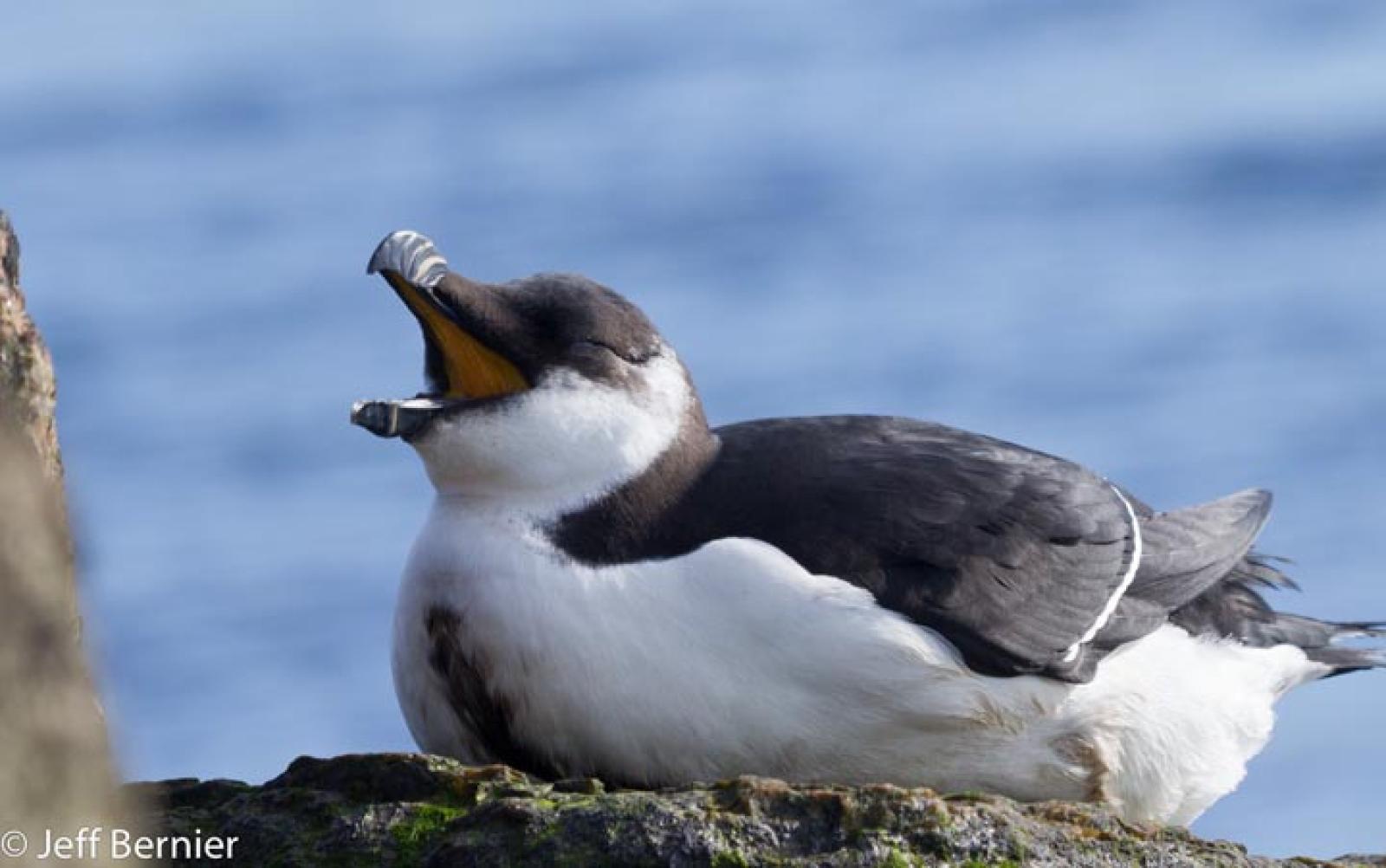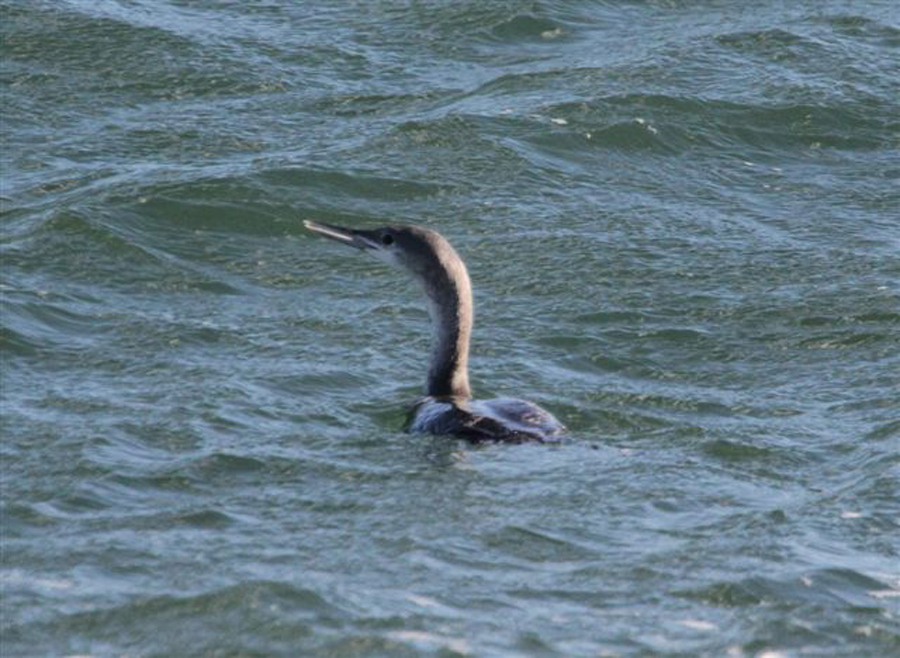This is the season not of the witch but the razorbill. They have been seen from every side of the Vineyard and Chappaquiddick. Unlike their cousins the puffins, dovekies, murres, guillemots, murrelets and auklets that remain offshore except to breed, the razorbills will come into harbors, bays and estuaries that are less salty than the ocean to feed. Razorbills will also enjoy a bit of R& R on a breakwater in the sun. The waters around the Vineyard are full of sand lances (sand eels) and still even mackerel, and where there are fish there are razorbills.
Razorbills use their wings to swim underwater to capture their fish food. Female razorbills could be considered hussies, as they hustle several male razorbills into competition before they choose a mate. Once a mate is selected the pair remains together for life. That can be quite a long time; one razorbill that was banded and recovered alive and well on a nest was 38 years old!
The only place in the U.S. that razorbills breed is in the state of Maine. The vast majority of razorbills nest in rocky cliffs in Iceland.
The Vineyard Haven and Edgartown harbors, the Oak Bluffs and Menemsha breakwaters and off South Beach are all areas where crow-sized black and white razorbills can be seen well this winter. Get out on a sunny day and try to find one or more.
Bird Sightings
Robert Levine called to say that he had seen a couple of birds that were not in his bird book. He proceeded to describe them and I thought from the color that they were peacocks. I suggested that they might belong to Arnie Fischer. I was wrong. The birds in question, according to Robert Levine’s research and Gus Ben David, are green pheasants. They have been seen near Nip ’n’ Tuck Farm and Cottle’s on Lambert’s Cove. Green pheasants are native to Japan, where they are actually the national bird. In the U.S. green pheasants have interbred with common (ring-necked) pheasants. The green pheasants are also known as veriscolor pheasants and have been bred by the Massachusetts Division of Fish and Wildlife and large commercial poultry farms. I called around to find out where these pheasants had come from and discovered that the Land Bank had released 120 birds in October, some at Peaked Hill, some at Sepiessa and the remaining at Waskosim’s Rock. I’m not sure where the birds Robert Levine has in his yard came from, but I would wager it is probably Sepiessa.
David Stanwood heard and stealthily crept up and observed two great horned owls near his Lambert’s Cove home on Jan. 4. And as only David would know, the owls’ synchronized hooting occurred every 15 seconds, one “a pure major third flat” compared to the other. What a great experience!
Bert Fischer sent a photo of a razorbill on the Menemsha breakwater sitting on the #3 day marker side on Jan. 5.
Peter Enrich counted more than 12 red-breasted mergansers and six hooded mergansers and a small flock of gadwalls in Squibnocket Pond on Jan. 6.
Allan Keith took a trip to Cape Pogue and Wasque on Jan. 5; he counted close to 250 greater scaup in Cape Pogue Pond and suggested that the flock should be studied because it may include such goodies as canvasback, redhead or tufted ducks. Other birds Allan saw included red-necked grebe, gadwall, a few long-tailed ducks, two horned larks on East Beach, a lesser black-backed gull, black-legged kittiwakes, over 100 razorbills, five northern flickers, 25 myrtle (yellow-rumped) warblers, one Ipswich sparrow, three gray catbirds and a hermit thrush. At Mytoi Allan found a brown creeper and a white-throated sparrow. Allan stopped at the Oak Bluffs Pumping Station on the way home and spotted nine black-crowned night herons and one ring-necked duck.
Kathy Perry spotted a hawk in her yard Jan. 2. By the description we decided it was a Cooper’s hawk.
Flip Harrington and I joined Allan Keith at Squibnocket on Jan. 7. Our best birds were a pair of blue-winged teal, a winter wren, a yellow-breasted chat, American coot, gray catbird and field and swamp sparrows.
Tim Johnson sent a nice photo of a great blue heron basking in the sun at Menemsha on Jan. 8. The next day Tim sent a photo of brant swimming off East Chop.
Penny Uhlendorf informed me that at 5:30 p.m. on Jan. 8 she heard a great horned owl calling near her Pilot Hill home. Shortly thereafter it headed towards Lambert’s Cove. Sounds like David Stanwood and Penny are sharing great horned owls!
Rob Culbert informed me that American woodcocks were displaying at Felix Neck on Jan. 9.
Jeff Bernier sent some fine photos of razorbills and purple sandpipers on the Menemsha breakwater and a surf scoter offshore on Jan. 10. The same day I had my first hairy woodpecker of the winter at the Quenames feeder.
Please report your bird sightings to the Martha’s Vineyard Bird Hotline at 508-645-2913 or e-mail to birds@mvgazette.com. Susan B. Whiting is the coauthor of Vineyard Birds and Vineyard Birds II. Her Web site is vineyardbirds2.com.









Comments (1)
Comments
Comment policy »